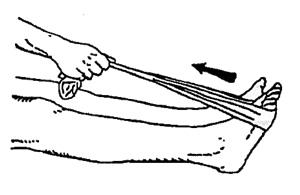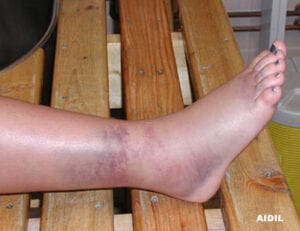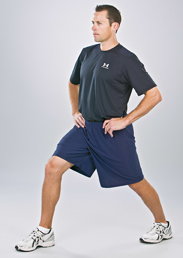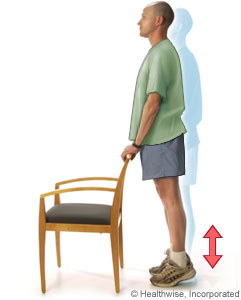What does an Ankle Sprain feel like?
An ankle sprain is when you tear one or more of the ligaments which hold your ankle bones in place. The degree of sprain depends on what proportion of the ligament and how many ligaments are torn. Often it will happen when your foot rolls inwards unexpectedly (e.g. when you land awkwardly while playing sport, if you slip on the edge of a pavement or on uneven surfaces). Often you will feel or hear a pop or clunking sensation. A bad ankle sprain will start to swell immediately, others may take 48 hours to swell, often bruising will also come up at this time.
Ankle sprains can look like this: Ouch!
What should I do?
RICE:
Rest – Stop any weight bearing exercise, limit how much walking you need to do. If you are limping, you may need crutches (your physio can help you with this).
Ice – Ice should be wrapped in a wet cloth and applied to the elevated ankle for 10-20 minutes 1-3 times per day if possible.
Compression – A compression bandage or tubi-grip will help reduced the amount of swelling (which encourages the ankle to heal faster). Compression needs to be quite firm, but comfortable and not restricting blood flow to the foot or ankle. You should not need to wear the compression at night.
Elevation – Elevating the affected limb above the level of the heart allows lymphatic return and reduces the amount of swelling.
Are there any exercises or stretches I can do at home?
YES!
1. Calf stretches: If you can comfortably stretch your calf muscle without causing any ankle pain this is an excellent stretch to do.
Early on, often you can stretch with a towel around the ball of your foot, hold the towel with your hands and pull back to straighten the knee and pull the toes back. Do not continue if it hurts your ankle. If the ankle feels ok you should hold for 30 seconds, 1-3 times daily.

Later you can try a standing calf stretch. Position your feet in parallel and keep the heel down on the back foot and lunge forward. You should feel a stretch in the back leg.
2. Calf Strengthening: Try doing heel raises standing with feet hip width apart, hold onto something in front of you, raise and lower your heels slowly, with control. Aim to do 2 sets of 10 repetitions.
3. Balance / proprioception exercises: Balance exercises will improve the reaction times of the muscles around the foot and ankle. Practice standing with two feet in tandem (one directly in front of the other). If this is easy try standing on one leg.
Always stand next to a steady bench to catch yourself if you lose balance. Aim to have 30 seconds of balancing time.
Should I go to the physio?
Your physiotherapist will assess the severity of your sprain, and can refer you for an x-ray if a fracture is suspected. As a general rule, if the ankle pain is restricting your walking you should see a physio, as often this means that your ankle joint itself is not moving normally and your calf muscle is getting tight. These two things particularly will slow your rate of healing. Your physiotherapist can perform joint mobilisation techniques and massage, amongst other techniques, to help improve your movement.
Any swelling in your ankle will reduce ankle flexibility and proprioception (this is part of your sense of balance which occurs within the ankle itself), hence it is very important to reduce swelling quickly and try to retrain your sense of balance as soon as is comfortable. Your physio can assist you with swelling management and with balance exercises as well as giving you exercises and stretches which are safe to do which will encourage normal movement and healing. These exercises will also improve the strength of the ligament as it heals, so you are better protected against re-injury.
Will I have ongoing problems?
Most people fully recover from ankle sprains, however many that do not seek appropriate treatment are left with a stiff ankle joint, which is one of the highest risk factors for re-spraining your ankle. Your physiotherapist can show you how to monitor ankle stiffness and also how to resolve it. Improving your proprioception (or balance reaction skills) will also reduce your risk of re-spraining your ankle. Your physiotherapist can give you more information on appropriate exercises for prevention of sprains.










